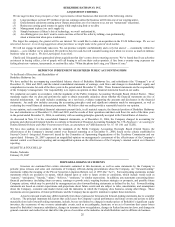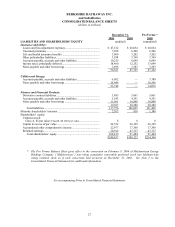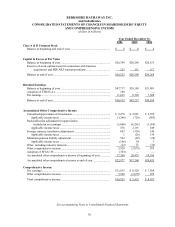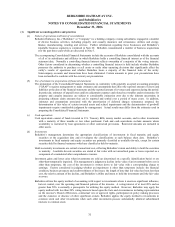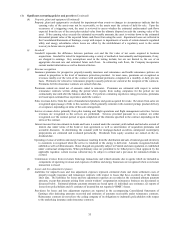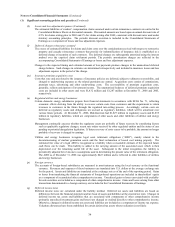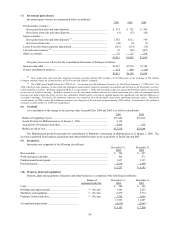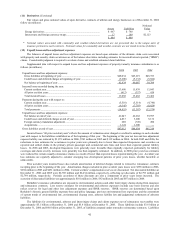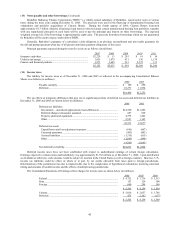Berkshire Hathaway 2006 Annual Report Download - page 36
Download and view the complete annual report
Please find page 36 of the 2006 Berkshire Hathaway annual report below. You can navigate through the pages in the report by either clicking on the pages listed below, or by using the keyword search tool below to find specific information within the annual report.35
(1) Significant accounting policies and practices (Continued)
(r) Accounting pronouncements to be adopted in subsequent years
In July 2006, the FASB issued FASB Interpretation No. 48 “Accounting for Uncertainty in Income Taxes” (“FIN 48”).
FIN 48 prescribes a recognition threshold and measurement attribute for financial statement recognition of positions
taken or expected to be taken in income tax returns. Only tax positions meeting a “more-likely-than-not” threshold
of being sustained are recognized under FIN 48. FIN 48 also provides guidance on derecognition, classification of
interest and penalties and accounting and disclosures for annual and interim financial statements. FIN 48 is
effective for fiscal years beginning after December 15, 2006. The cumulative effect of any changes arising from the
initial application of FIN 48 is required to be reported as an adjustment to the opening balance of retained earnings
in the period of adoption.
In September 2006, the FASB issued FASB Staff Position No. AUG AIR-1, “Accounting for Planned Major
Maintenance Activities” (“AUG AIR-1”). AUG AIR-1 prohibits the use of the accrue-in-advance method of
accounting for planned major maintenance activities in which such maintenance costs are ratably recognized by
accruing a liability in periods before the maintenance is performed. This pronouncement also retains three
alternative methods for accounting for planned major maintenance activities including the direct expensing method,
the built-in overhaul method and the deferral method. AUG AIR-1 is effective for fiscal years beginning after
December 15, 2006.
In September 2006, the FASB issued SFAS No. 157, “Fair Value Measurements” (“SFAS 157”). SFAS 157 defines
fair value as the price received to transfer an asset or paid to transfer a liability in an orderly transaction between
market participants at the measurement date reflecting the highest and best use valuation concepts. SFAS 157
establishes a framework for measuring fair value by creating a hierarchy of fair value measurements currently
required under GAAP that distinguishes market data between observable independent market inputs and
unobservable market assumptions. SFAS 157 further expands disclosures about such fair value measurements.
SFAS 157 is effective for fiscal years beginning after November 15, 2007 and may be adopted earlier but only if the
adoption is in the first quarter of the fiscal year.
In February 2007, the FASB issued SFAS No. 159, “The Fair Value Option for Financial Assets and Financial
Liabilities - Including an amendment of FASB Statement No. 115” (“SFAS No. 159”). SFAS No. 159 permits
entities to elect to measure many financial instruments and certain other items at fair value. Upon adoption of SFAS
No. 159, an entity may elect the fair value option for eligible items that exist at the adoption date. Subsequent to the
initial adoption, the election of the fair value option should only be made at initial recognition of the asset or
liability or upon a remeasurement event that gives rise to new-basis accounting. SFAS No. 159 does not affect any
existing accounting literature that requires certain assets and liabilities to be carried at fair value nor does it
eliminate disclosure requirements included in other accounting standards. SFAS No. 159 is effective for fiscal years
beginning after November 15, 2007 and may be adopted earlier but only if the adoption is in the first quarter of the
fiscal year.
Berkshire is evaluating the impact that the adoption of these pronouncements will have on its consolidated financial
position and currently does not anticipate that the adoption of these accounting pronouncements will have a material
effect on its consolidated financial position.
(2) Investments in MidAmerican Energy Holdings Company
MidAmerican owns a combined regulated electric and natural gas utility company in the United States (MidAmerican Energy
Company), a regulated electric utility company in the United States (PacifiCorp which was acquired March 21, 2006), two interstate
natural gas pipeline companies in the United States (Kern River and Northern Natural Gas), two electricity distribution companies in
the United Kingdom (Northern Electric and Yorkshire Electricity), a diversified portfolio of domestic and international electric power
projects and the second largest residential real estate brokerage firm in the United States (HomeServices). This group of businesses is
referred to as “MidAmerican” or the “utilities and energy businesses.”
On February 9, 2006, Berkshire converted its non-voting preferred stock to common stock and upon conversion, owned
approximately 83.4% (80.5% diluted) of the voting common stock interests. In conjunction with the acquisition of PacifiCorp,
Berkshire acquired additional common stock of MidAmerican for $3.4 billion. Berkshire’ s ownership in MidAmerican as of
December 31, 2006 was 87.8% (86.6% diluted). Accordingly, the 2006 Consolidated Financial Statements reflect the consolidation
of the accounts of MidAmerican. MidAmerican’ s debt obligations are not guaranteed by Berkshire. However, Berkshire has made a
commitment until February 28, 2011 that would allow MidAmerican to request up to $3.5 billion of capital to pay its debt obligations
or to provide funding to its regulated subsidiaries.
During 2004 and 2005, Berkshire possessed the ability to exercise significant influence on the operations of MidAmerican
through its investments in common and convertible preferred stock of MidAmerican, which together possessed 9.7% of the voting
rights and 83.4% (80.5% diluted) of the economic rights of MidAmerican. The convertible preferred stock, although generally non-
voting, was substantially an identical subordinate interest to a share of common stock and economically equivalent to common stock.
Therefore, during that period, Berkshire accounted for its investments in MidAmerican pursuant to the equity method. An unaudited
pro forma balance sheet as of December 31, 2005 is included on the face of the accompanying Consolidated Balance Sheets reflecting
the consolidation of MidAmerican. Walter Scott, Jr., a member of Berkshire’ s Board of Directors, controlled approximately 86% of
the voting interest in MidAmerican at December 31, 2005. As a result of Berkshire’ s conversion of its preferred stock to voting
common stock, at December 31, 2006, Mr. Scott’ s voting interest has been reduced to 11%.


